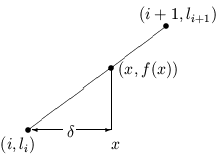(95 72 86 70 97 72 52 88 77 94 91 79 61 77 99 70 91)
1
1 1
1 2 1
1 3 3 1
1 4 6 4 1
Each new level of the triangle has 1's on the ends; the interior numbers are the sums of the two numbers above them. Write a program (binomial n) to produce a list of binomial coefficients for the power n using the Pascal's triangle technique. (binomial should be a recursive program that manipulates lists; it should not use use (choose n k).) Use the function (choose n k) that you wrote earlier to calculate (choose 4 k) for k from 0 through 4; what is the relationship between these values and the binomial coefficients?
For example, suppose that l = (0 30 56 78 96 ...). The value for x = 3 is 78, and the value for x = 4 is 96. (interpolate l 3.4) = 85.2, i.e., 78 + .4 * (96 - 78) .

Use your interpolate function to make the binary coefficient list for n = 12 look like a function and plot it using your plotting program. What is the shape of this curve?
- Write a function (findpath item cave) that will find a path
to a part of cave that matches item; use eqv? to
test for equivalence. findpath returns #f if item
does not occur in cave; otherwise, it returns a list of
car's and cdr's that describes the path to the item.
findpath is easily written as a recursive function.
Examples:
(findpath 'a 'b) = #f (findpath 'a 'a) = () (findpath 'a '(a)) = (car) (findpath 'gold '(rocks gold (monster))) = (cdr car)
- Write an interpreter (follow path cave) that will follow
a path as returned by findpath and retrieve the contents of
cave at the location specified by path.
- Write a function pathtocode that will convert a list of
steps produced by findpath into Lisp code to extract the item
from a variable x that points to the top of the tree.
Hint: look at the reverse function.
(pathtocode (findpath 'gold '(rocks gold (monster))) = (car (cdr x))
- Write a function (makedefine fn vars code) that makes a
define form for a function named fn whose arguments
are vars (a list of variable names) and whose code is code.
- A robot is to be sent into the cave to retrieve the treasure;
naturally, the robot is programmed in Scheme.
Write a function (pathfn fn item cave) that will create
and define a function named fn to get the specified
item from the cave. Use eval to execute the
define form produced by makedefine. Test the function
to verify that it does extract the item from the cave. Example:
(define cave '(a (b ((c) d) (e (f)) g) h . i)) (pathfn 'get-f 'f cave) => (define (get-f x) (car (car (cdr (car (cdr (cdr (car (cdr x))))))))) (get-f cave) = f
Verify that your program pathfn can make a function to retrieve any of the letters in cave. You now have written a Scheme program that writes Scheme programs! -
Write a recursive function (corresp item tree1 tree2) that finds
the item, corresponding to item in tree1,
in tree2. Example:
(corresp 'light '((my eyes) (have seen (the light))) '((my ears) (have heard (the music)))) ==> music - Write a second version of (corresp item tree1 tree2) using pathfn.